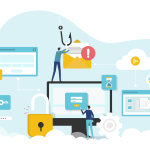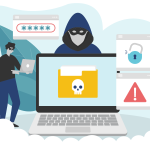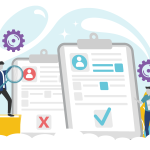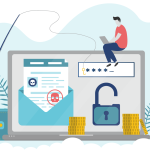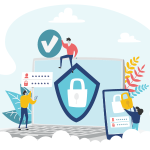16 Essential Cybersecurity Tips For Every SMB
May 15, 2025
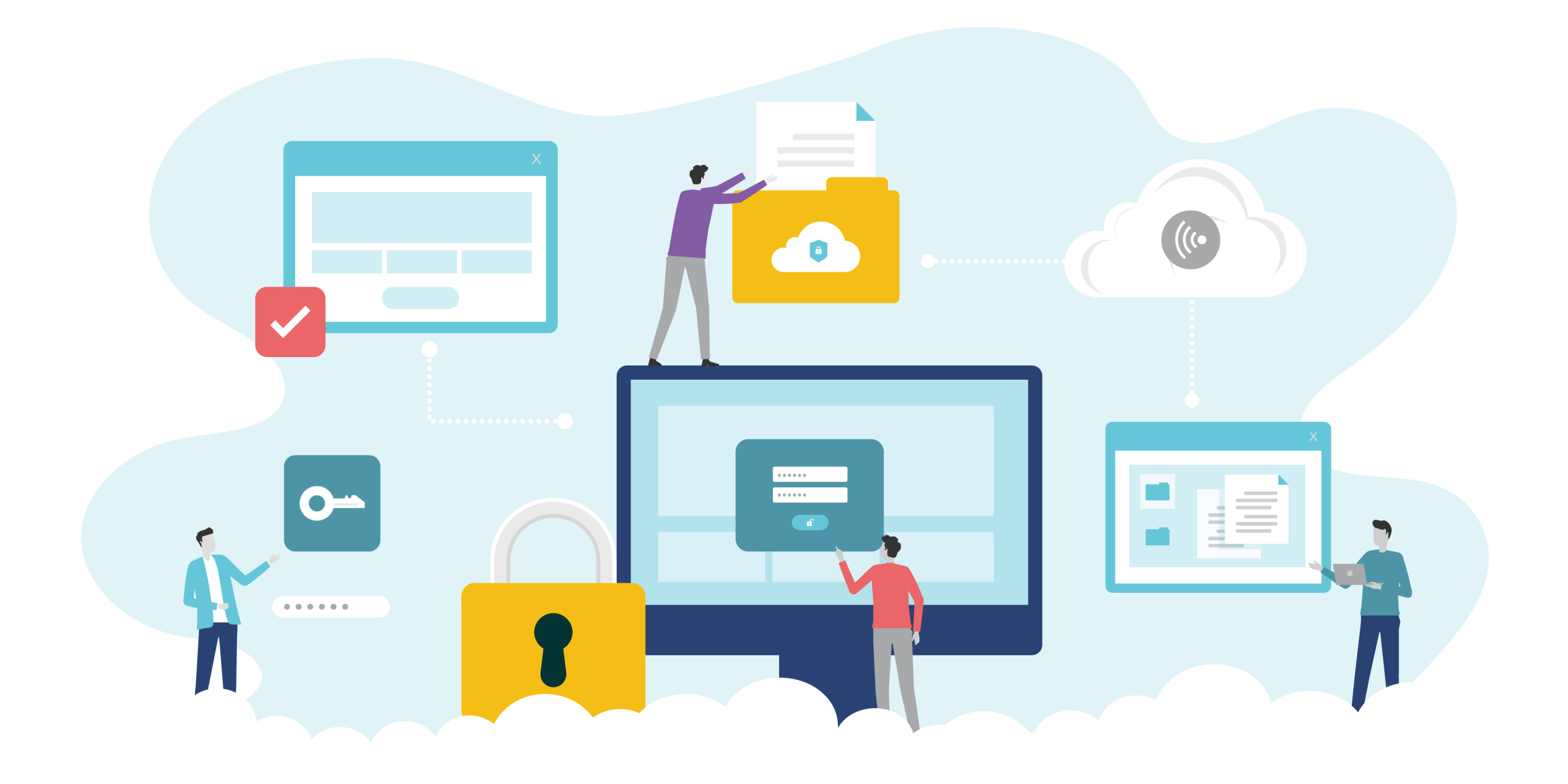
In today’s increasingly digital landscape, cyber risks are more prevalent than ever—and they’re not just a big-business problem. In fact, cybercriminals often see small to medium businesses (SMBs) as easy targets, assuming they lack the resources or expertise to defend themselves.
The reality is that a single breach could be devastating for your business, leading to financial loss, reputational damage, and even business closure. But here’s the good news: most cyber threats can be stopped with the right security measures in place.

Strong cybersecurity isn’t just an IT concern, it’s a business necessity. With more data, transactions, and operations happening online than ever before, bolstering your cyber defenses is the key to protecting your company’s future. To help you out, here’s our list of 16 essential cybersecurity best practices that every SMB should implement!
Disclaimer: Please note that the information provided herein offers guidelines only. It is not exhaustive and does not constitute legal or cybersecurity advice. For more guidance, please consult a lawyer, a licensed insurance representative, and/or a cybersecurity specialist.
1. Strengthen your passwords.
Your password is the first line of defense against cyber threats, so it should come as no surprise that weak passwords are one of the easiest ways for hackers to infiltrate systems and access sensitive information.
A strong password policy is a simple step that can make a huge difference in keeping your business safe. Require your employees to use unique, complex passwords that include a mix of letters, numbers, and symbols, and encourage the use of password managers to securely generate and store strong credentials.
Avoid reusing old passwords and consider using Single Sign-On (SSO) solutions wherever possible to streamline authentication. This will help reduce the number of passwords employees need to manage without compromising protection.
2. Enable multi-factor authentication.
Passwords alone aren’t enough to keep hackers out—multi-factor authentication (MFA) adds an essential extra level of protection. MFA is a security process that requires users to verify their identity using two or more factors, like a password along with a one-time code sent to their phone, a biometric scan, or a hardware token.
In fact, Microsoft reports that more than 99.9% of compromised accounts don’t have MFA enabled! With MFA in place, even if your login credentials are weak, stolen, or leaked, attackers still can’t gain access without an additional form of verification.
Businesses should prioritize implementing MFA wherever possible, especially for system administrators, senior executives, and other privileged users on critical systems, including email, cloud applications, and financial accounts.
RELATED: Multi-Factor Authentication: Why Passwords Aren’t Enough Anymore
3. Protect your network with firewalls and cybersecurity software.
A secure network is the backbone of a resilient business. Start by configuring firewalls and enabling anti-virus and anti-malware software on all connected devices that scan for potential threats automatically. Layer in email filtering, anti-phishing software, and DMARC (Domain-based Message Authentication, Reporting & Conformance) protocols to defend against email-based attacks like spoofing and phishing.
Finally, bolster your defenses with Endpoint Detection and Response (EDR) software. EDR tools continuously monitor activity on endpoints—like laptops, servers, and mobile devices—to detect suspicious behaviour, analyze threats, and enable a fast response. This proactive approach strengthens your security perimeter and helps you catch threats before they cause damage.
RELATED: Prepare Now or Pay Later: How Can Businesses Mitigate the Risk of Ransomware?
4. Use secure connections.
Always ensure that your business data travels through secure channels. Use HTTPS for websites, SSL/TLS for email and data transmission, and VPNs for remote access to your network. These encrypted connections protect sensitive information from being intercepted or tampered with during transmission.
Avoid public Wi-Fi networks, disable automatic connections to open networks, and encourage the use of corporate Wi-Fi or cellular data over public hotspots. Limit the use of Bluetooth and NFC when handling sensitive information to reduce exposure. By prioritizing secure connections across your systems, you reduce the risk of man-in-the-middle attacks, data leaks, and unauthorized access.
RELATED: Working from Anywhere? Here’s Why Your Company Should Worry
5. Keep software and systems up-to-date.
Outdated software is one of the easiest ways for cybercriminals to exploit your business. New updates aren’t just about adding features, they often include critical patches that fix security vulnerabilities, bugs, and performance issues. Failing to update your systems leaves the door wide open for attackers to exploit known security flaws.
Enable automatic updates wherever possible to quickly patch vulnerabilities as they’re discovered. Don’t hang on to old, unsupported software either—replace it with secure, up-to-date alternatives to keep your systems resilient against new and evolving threats.
6. Encrypt your data.
In the event of a breach or stolen device, encryption acts as a final line of defense, keeping your data unintelligible and useless to attackers. Whether information is being stored on a device or transmitted across networks, encryption ensures it can only be read by those with the correct decryption key. This is especially crucial for safeguarding financial data, client information, proprietary business materials, and personal records.
To keep your business data secure, be sure to encrypt sensitive information at rest (data that’s stored) and in transit (data that’s being transmitted) using strong, up-to-date protocols. Enable full disk encryption on all devices, secure communications with VPNs or encrypted email, and manage encryption keys carefully. Use tools with end-to-end encryption, train employees on safe data handling, and ensure lost or stolen devices can be wiped remotely.
RELATED: Encryption Basics: What is it, Best Practices, & More
7. Back up your data regularly.
Data loss from cyberattacks, hardware failure, or human error can be devastating, but a strong backup strategy is one of the best safety nets your business can have. Implement automated daily or weekly backups to ensure critical information is always protected. Store backups securely offline or in trusted cloud storage, and make sure they’re encrypted to prevent unauthorized access.
Businesses should back up all systems containing essential information to a secure, offsite location and restrict access to backup data for testing or restoration purposes only. Regularly test your backups to confirm they can be restored quickly and reliably when needed.
RELATED: Prepare Now or Pay Later: How Can Businesses Mitigate the Risk of Ransomware?
8. Conduct regular cybersecurity awareness training.
Human error is one of the leading causes of privacy breaches. Your employees play a crucial role in keeping your business secure, and regular cybersecurity training ensures they’re prepared to recognize and respond to threats. Training should focus on practical, easy-to-implement practices like creating strong passwords, recognizing malicious emails and suspicious links, avoiding public Wi-Fi, enabling multi-factor authentication (MFA), keeping devices updated, and practicing caution on social media.
Educate your team on common attack methods like phishing and social engineering, and run simulated phishing tests to sharpen their instincts against real-world threats. Tailor your training to your industry—scams targeting healthcare organizations will look different from those targeting financial services. Most importantly, keep training sessions fresh and up-to-date, so employees stay alert to the latest tactics cybercriminals are using.
RELATED: Security Awareness Training: What is it, Best Practices, & More
9. Secure cloud and outsourced IT services.
Your company might be using a third-party service without even fully realizing who you’re handing over sensitive data and system access to! As more businesses rely on cloud platforms and outsourced IT providers, securing these environments is critical.
Implement strong cloud security controls, including data encryption, secure access, and regular reviews of sharing permissions and integrations. Always assess the security settings and configurations of your cloud storage to prevent accidental exposure.
Ensure your cloud service providers comply with recognized standards and the privacy regulations of the jurisdictions where your business operates and where your clients are located. Thoroughly evaluate how your vendors handle, access, and store your sensitive information. Finally, make sure all communication between your users and the cloud is secure—because when it comes to outsourcing, your data is only as safe as your weakest link.
RELATED: Decoding MSPs: Your Guide to Outsourcing IT Services
10. Implement access control measures.
Apply the principle of least privilege by only granting users the minimum access they need to do their jobs. Regularly review and update user permissions to reflect role changes or departures. For larger businesses, implementing a centralized access control system can help manage authorizations more efficiently and securely, streamlining the onboarding/offboarding process and maintaining compliance with data protection regulations.
Having proper access control measures in place can help you identify which employee account was involved in a breach and where it originated, limit the damage if an account is compromised, and significantly reduce the risk of an internal privacy breach.
11. Monitor and audit system activity.
Effective cybersecurity goes beyond prevention—it’s also about detection. Implement logging and monitoring tools to track user activity and system changes in real-time, helping you spot suspicious behaviour quickly and respond before the damage is done.
Stay one step ahead of potential threats by conducting regular security audits and risk assessments to identify vulnerabilities and ensure that your controls remain effective. Monitor your access control lists and audit logs to keep track of who is viewing what, when, and how often.
12. Develop an incident response plan.
No matter how strong your defenses are, cyber incidents can still happen—and when they do, a clear, well-prepared, and up-to-date response plan can make all the difference. Every business should have a written incident response plan (in both digital and physical format) that outlines exactly how to handle different types of incidents, from minor breaches to major system compromises.
The plan should clearly define roles and responsibilities, include contact information for key internal team members and external stakeholders (such as legal counsel, insurers, and regulators), and establish communication protocols. A strong response plan helps minimize damage, reduce downtime, and protect your reputation.
RELATED: Are You Prepared for a Data Breach? The Ultimate Incident Response Plan Checklist
13. Exercise caution when using AI.
Generative AI tools offer huge potential for efficiency and innovation, but as technology becomes more powerful, so do the risks. Cybercriminals are already leveraging AI to scale up attacks (e.g. more convincing phishing scams, deepfake impersonations, and automated vulnerability scanning), while businesses face growing concerns around data privacy, misuse, and leaks.
You don’t necessarily need to avoid AI altogether—just use it wisely. Before adopting any AI tools, research the provider’s background, data handling practices, and privacy policies. Educate your team on safe usage, and set clear internal guidelines around what information can be entered into AI platforms. Always ensure your AI practices comply with legal, regulatory, and industry standards.
14. Consider a cyber scan.
As cyber threats grow more sophisticated, insurers are tightening their requirements for Cyber Insurance—with most expecting the foundations to be in place: multi-factor authentication (MFA), data encryption, offline backups, and security awareness training for all employees. But that’s just the beginning. Many insurers are also using third-party scanning tools to evaluate your systems, flag vulnerabilities, and determine your overall insurability—often without giving you a chance to remediate issues before denying or cancelling coverage.
While completing a cyber scan on your own might feel like just another added cost, the fallout of recovering from a cyberattack will be significantly higher. After all, it only takes one small vulnerability to open the door to a major breach. With a Cyber Insurability Assessment, you can spot and fix system weaknesses before they’re exploited, stay ahead of evolving insurance requirements, and ensure your business is properly protected.
15. Invest in Cyber Insurance.
No matter how much you prepare, it’s impossible to avoid 100% of cyber incidents. That’s where Cyber Insurance comes to the rescue. It acts as a financial safety net, helping your company recover from a cyberattack by covering costs associated with data breaches and system outages. With the right policy in hand, you can reduce the financial strain of a breach and focus on getting your operations back on track.
Coverage highlights include:
- Legal fees, damages, and defence costs;
- A specialized data forensics team to investigate the cause of the breach;
- A legal breach coach to advise you on response and regulatory compliance;
- Client notification and credit monitoring for affected parties;
- PR consulting services to manage reputational harm;
- And more!
Most policies also include Third-Party Liability Coverage to pay damages and defence costs if you’re sued by a third-party, like a candidate or a client, who was affected by a breach on your network.
RELATED: All About Cyber Insurance: What is it, What’s Covered, and Why Do You Need it?
16. Partner with a broker.
Having an experienced partner in risk management on your side will give you the peace of mind knowing that you’re covered in the event of a cyber breach. Enter PROLINK. As a licensed broker with over 40 years of experience and a specialized knowledge of cyber threats, we’ll work with you to build a strong defence and ensure your business is ready for whatever comes next. Our dedicated team of risk advisors will:
- Identify exposures based on your business operations and unique needs;
- Share what steps others in your industry are taking and advise you accordingly;
- Outline a proactive approach to risk management to control your costs long-term;
- Conduct a robust assessment of your existing insurance policies to detect any coverage gaps;
- Secure a specialized solution that aligns with your strategic objectives.
When it comes to cybersecurity, it’s always better to be safe than sorry. To learn more about your exposures and how you can protect yourself, visit our Cyber Security & Privacy Breach Toolkit and connect with PROLINK today for more guidance!
PROLINK’s blog posts are general in nature. They do not take into account your personal objectives or financial situation and are not a substitute for professional advice. The specific terms of your policy will always apply. We bear no responsibility for the accuracy, legality, or timeliness of any external content.
